The Enchanting World of Indonesian Rivers
Indonesia, a sprawling archipelago nation, is renowned for its breathtaking landscapes, rich biodiversity, and captivating cultural heritage. Amidst this tapestry of natural wonders, rivers play a pivotal role, weaving through the heart of the islands and nourishing the very lifeblood of the nation. But beyond their practical significance, Indonesian rivers are steeped in a vibrant world of myth and folklore, where the boundaries between the real and the supernatural blur. These mythical rivers, with their swirling currents and whispering reeds, have long served as pathways to the spiritual realm, embodying the hopes, fears, and aspirations of the Indonesian people.
Mythical Rivers as Pathways to the Supernatural
Indonesian folklore is teeming with tales of mythical rivers that connect the earthly realm to the supernatural. These rivers are not merely bodies of water; they are portals to a world beyond human comprehension, where spirits dwell, magic flourishes, and the laws of nature are suspended. Imagine a river that flows through a dense jungle, its waters shimmering with an otherworldly glow, its banks adorned with ancient trees that whisper secrets in the wind. This is the world of Indonesian river mythology, where the commonplace becomes extraordinary, where the ordinary yields to the mystical.
The Significance of River Spirits: Guardians and Guides
At the heart of Indonesian river mythology lie the river spirits, powerful entities that embody the essence of these waterways. These spirits, often depicted as beautiful nymphs, fierce dragons, or ancient deities, are not just figments of imagination; they are integral to the cultural fabric of Indonesia. They are revered as protectors, guides, and arbiters of fate. They are believed to govern the flow of the rivers, control the bounty of the land, and determine the prosperity of the people. Offerings are made to appease their spirits, prayers are whispered to solicit their favor, and festivals are held to honor their presence. The river spirits are a constant reminder of the interconnectedness of humans and nature, of the reverence for the forces that shape our world.
The Bengawan Solo: A River of Ancient Lore and Transformation
The Bengawan Solo, the longest river in Java, is a river steeped in history and mythology. It flows through a landscape of ancient temples, bustling cities, and verdant rice fields, a testament to the enduring spirit of the Indonesian people. In the realm of folklore, the Bengawan Solo is a river of transformation and rebirth. Legend has it that the river was once a giant python that was magically transformed into a river by a powerful sage. The river's serpentine path reflects this mythical origin, winding through the landscape like a colossal serpent. It is said that the Bengawan Solo possesses the power to cleanse the soul, to wash away past transgressions, and to usher in a new beginning. This mythical significance has made the Bengawan Solo a symbol of hope and renewal for the people of Java.
The Batang Hari: A River of Royal Lineage and Prophecy
The Batang Hari, a river that flows through the heart of Sumatra, is not just a source of life; it is also a river of lineage and prophecy. In the ancient chronicles of the Malay people, the Batang Hari is depicted as a river of royal blood, a sacred waterway that links the present to the past. The ancestors of the Malay kings are said to have emerged from the Batang Hari, making it a symbol of their lineage and their claim to power. The river is also associated with prophetic dreams, where the spirits of the river reveal the future to those who are worthy. The Batang Hari, with its flowing currents, is a repository of history, a witness to the rise and fall of dynasties, a harbinger of future events, and a reminder of the enduring legacy of the Malay people.
The Kapuas River: A Gateway to the Underworld and the Land of the Dead
The Kapuas River, the longest river in Borneo, is not just a waterway; it is a portal to the realm of the dead, a mythical river that connects the living with the spirits of the departed. In the mythology of the Dayak people, who have inhabited Borneo for centuries, the Kapuas River is believed to flow into the underworld, a subterranean realm where the souls of the deceased reside. The river’s journey to the underworld is fraught with danger, as it is guarded by ferocious river spirits and mythical creatures. The Dayak believe that only those who have lived a virtuous life can successfully navigate the treacherous currents and reach the realm of the departed. The Kapuas River is a reminder of the fragility of life and the importance of living a life worthy of the afterlife. It is a testament to the Dayak people’s reverence for their ancestors and their beliefs about the cyclical nature of life and death.
The Citarum River: An Embodiment of Fertility and the Cycle of Life
The Citarum River, a vital waterway in West Java, is more than just a source of life; it is a symbol of fertility, renewal, and the eternal cycle of life. In Javanese mythology, the Citarum River is associated with Dewi Sri, the goddess of rice and agriculture. She is believed to reside in the river’s depths, her presence bestowing bountiful harvests upon the land. The river’s fertile waters and the abundance they bring are a testament to Dewi Sri’s power and her role as a guardian of the land. The Citarum’s rich mythology is woven into the fabric of Javanese culture, reminding people of the importance of respecting the natural world and honoring the forces that sustain life.
Themes of Creation and Destruction in River Mythology
Throughout Indonesian river mythology, there are recurring themes of creation and destruction, reflecting the cyclical nature of the natural world. Many legends tell of rivers that were created by powerful deities or mythical beings, shaping the landscape and bringing life to the land. The Bengawan Solo, for example, is said to have been transformed from a giant python into a river by a sage, symbolizing the power of transformation and the divine intervention in shaping the world. Other legends depict rivers as forces of destruction, capable of unleashing floods and causing devastation. These tales highlight the ambivalent nature of rivers, their ability to sustain life as well as bring ruin. They serve as reminders of the power of nature and the need for humans to live in harmony with the environment.
The Influence of Animism and Hinduism on River Myths
Indonesian river mythology is a vibrant tapestry woven from the threads of animism and Hinduism. Animism, a belief system that attributes spirits to natural phenomena, is deeply ingrained in Indonesian culture. The belief that rivers are inhabited by spirits, often depicted as nymphs, dragons, or deities, is a testament to this animistic worldview. Hinduism, introduced to Indonesia centuries ago, has had a profound influence on river mythology. The worship of river deities, such as Dewi Sri and the Ganga, is a direct reflection of Hindu beliefs. These deities embody the power and fertility of rivers, embodying the sacredness of water and the divine forces that govern nature. The fusion of animistic beliefs with Hindu influences has created a rich and complex tapestry of river mythology in Indonesia, reflecting the country’s diverse cultural heritage.
Interpreting River Myths: Reflections of Nature and Human Society
Indonesian river mythology offers a unique window into the cultural mindset of the Indonesian people. These tales are not mere fantastical stories; they reflect deep-seated beliefs about nature, human society, and the interconnectedness of all living things. River spirits serve as guardians, protectors, and guides, representing the power and mystery of the natural world. The cyclical nature of rivers, their ability to sustain life and bring destruction, mirrors the ebb and flow of human existence. And the reverence for river deities highlights the importance of honoring the forces that govern our lives. By understanding Indonesian river mythology, we gain a deeper appreciation for the cultural values, beliefs, and worldview of the Indonesian people.
.
FAQ
What are some interesting facts about Indonesian river mythology?
- Indonesian river mythology is rich with stories about river spirits, often depicted as nymphs, dragons, or deities.
- The Bengawan Solo river is said to have been transformed from a giant python by a sage.
- The Batang Hari river is linked to royal lineage and prophecy.
- The Kapuas River is believed to flow into the underworld, a realm of the dead.
- The Citarum River is associated with Dewi Sri, the goddess of rice and agriculture.
How does Indonesian river mythology reflect the country's cultural heritage?
- Indonesian river mythology reflects the country's animistic worldview, where spirits are believed to inhabit natural phenomena.
- Hinduism has also played a significant role in shaping river mythology, with the worship of river deities such as Dewi Sri and the Ganga.
- River mythology highlights the importance of nature, the cyclical nature of life, and the reverence for ancestors.
What are some of the key themes found in Indonesian river mythology?
- Creation and destruction: Rivers are seen as both life-giving and destructive forces, reflecting the cycle of the natural world.
- Transformation: Rivers are often associated with change and rebirth, symbolizing the potential for renewal.
- Lineage and prophecy: River spirits can reveal the past and predict the future, connecting generations.
- The underworld: Rivers serve as pathways to the realm of the dead, highlighting the importance of the afterlife.
What are some of the practical implications of Indonesian river mythology?
- River mythology fosters respect for the natural world and encourages the preservation of rivers.
- It serves as a reminder of the interconnectedness of humans and nature.
- It promotes a sense of community and shared history.
- It provides a framework for understanding the forces that govern our lives.
.




